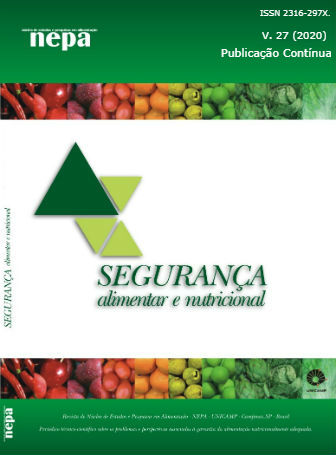Abstract
The objective of the research was to analyze the stages of purchase, storage and distribution of food of animal origin, destined to the school feeding of Piracicaba, state of São Paulo, in order to identify possible impasses that could compromise the quality of these products. Semi-structured questionnaires were used directed to the Manager and Nutritionist responsible for the National School Feeding Program – PNAE, suppliers of animal foods and lunch makers, as well as information contained in the bidding documents for the purchase of these foods between 2014 and 2017. The results revealed difficulties in describing the products, in complying with the rules of the bidding procedures and in the elaboration of the quality standards. There were problems with suppliers regarding the replacement or replacement of products, non-compliance with the dates and quantities requested and the delivery of products with inadequate sensory quality. We found the need to provide school units with infrared thermometers. The lunch makers must be responsible for the correct checking of the food, checking the integrity of the packaging and observing the cleanliness of the deliverers and vehicles. Implementing standardized processes for refusal of food at the time of delivery to schools is necessary because some discrepancies of the procedures performed were verified. Problems regarding the storage of food of animal origin in the cold chambers were also found. The review of the bidding process and its clauses related to administrative penalties and sensory analysis, as well as providing thermometers for the measurement and recording of temperatures and the standardization of actions regarding the refusal of products, can contribute to the maintenance of satisfactory quality standards of school feeding of the analyzed municipality.
References
BRASIL. Ministério da Educação. Resolução n. 26, de 17 de junho de 2013. Dispõe sobre o atendimento da alimentação escolar aos alunos da educação básica no âmbito do Programa Nacional de Alimentação Escolar – PNAE. Brasília: Diário Oficial da União. 17 jun 2013.
Santana TCM. Formação do nutricionista atuante no Programa Nacional de Alimentação Escolar: Um estudo transversal sobre perfil profissional, trajetória de formação e demandas de aprimoramento. São Paulo. Dissertação [Mestrado em Ciências da Saúde]- Universidade Federal de São Paulo; 2011.
Minitab 18.1 Statistical Software (2017). [Computer software]. State College, PA: Minitab, Inc.
BRASIL. Ministério da Agricultura, Pecuária e Abastecimento. Instrução Normativa n. 69, de 13 de dezembro de 2006. Instituir critério de avaliação da qualidade do leite in natura, concentrado e em pó, reconstituídos, com base no método analítico oficial físico-químico denominado “Índice CMP”, de que trata a Instrução Normativa n. 68, de 12 de dezembro de 2006. Brasília, Diário Oficial da União. 15 dez 2006.
Robim MS. et al. Pesquisa de fraude no leite uat integral comercializado no estado do rio de janeiro e comparação entre os métodos de análises fisicoquímicas oficiais e o metódo de ultrassom. Rev Inst Latic “Cândido Tostes”. 2012:67(389):43-50. Disponível em: https://www.revistadoilct.com.br/rilct/article/view/225/235.
TABELA Brasileira de Composição de Alimentos - TACO. 4. ed. rev. amp. Campinas: UNICAMP, 2011. 161 p.
Mesquita MO, Fries LLM, Valente T. Safety criteria for the acquisition of meat in Brazilian University restaurants. Food Science and Technology, Campinas. 2014:34(1):102-109. Disponível em: http://www.scielo.br/scielo.php?script=sci_arttext&pid=S0101-20612014000100015.
SÃO PAULO (Estado). Centro Vigilância Sanitária. Portaria CVS 5, de 09 de abril de 2013. Aprova o regulamento técnico sobre boas práticas para estabelecimentos comerciais de alimentos e para serviços de alimentação, e o roteiro de inspeção, anexo. Disponível em: http://www.cvs.saude.sp.gov.br/up/PORTARIA%20CVS-5_090413.pdf.
Monteiro CC, Costa RR., Braga ALM. Capacitação de merendeiras da rede pública do município de Puxinanã-PB. In: 16 SAFETY, HEALTH AND ENVIRONMENT WORLD CONGRESS; 2016, Salvador. Bahia. Disponível em: http://copec.eu/shewc2016/proc/works/5.pdf.
Silva VB, Cardoso RCV. Controle da qualidade higiênico-sanitária na recepção e no armazenamento de alimentos: um estudo em escolas públicas municipais de Salvador, Bahia. Rev Segurança Alimentar e Nutricional. 2011:18(2)43-57. Disponível em: https://periodicos.sbu.unicamp.br/ojs/index.php/san/article/view/8634687/2606.
A revista Segurança Alimentar e Nutricional utiliza a licença do Creative Commons (CC), preservando assim, a integridade dos artigos em ambiente de acesso aberto.


